Biology > EXAM > BIO 201 Test_ Anatomy and Physiology Chapter 41 _ Quizlet (GRADED A+) Questions and Answer solutions (All)
BIO 201 Test_ Anatomy and Physiology Chapter 41 _ Quizlet (GRADED A+) Questions and Answer solutions | 100% Correct solutions
Document Content and Description Below
104 Multiple choice questions 1. superficial and deep connective tissue layers of the body internal layers and wrappings consisting of connective tissues support/surround organs provide strength ... and stability maintain positions of internal organs passageway for blood vessels, lymphatic vessels, nerve NAME A. lacunae B. fibrocytes C. neurons D. fasciae 2. contact points between the plasma membranes of tissue cells A. absorption B. hemidesmosomes C. tight junctions D. cell junctions 3. mature cells A. pleura B. -blasts C. -cyte D. visceral 4. membrane proteins called connexons that connect neighboring cells A. spongy bone B. hyaluronidase C. absorption D. gap junctions 5. endo-inside crine-secretion called hormones, enter the interstitial fluid then diffuse directly into bloodstream (capillaries) without flowing through a duct (ductless) -have far reaching effects bc distributed thru bloodstream ex) thyroid gland tend to form rosettes A. apocrine glands B. merocrine glands C. endocrine glandular epithelium D. Bone tissue/osseous tissue 6. found b/w adjacent muscles A. transitional B. deep fascia C. adipoctyes D. blood plasma 7. store calcium& phosphorus, house red bone marrow, storage site for triglycerides -composed of periosteum, red/yellow bone marrow, endosteum 1)greatest strength 2)strongest support cells:osteocytes G.S:mineral salt crystals (calcium) fibers: collagen A. endocrine glandular epithelium B. exocrine glandular epithelium C. extracellular matrix D. Bone tissue/osseous tissue 8. group of cells that usually have a common origin in an embryo and function together to carry out specialized activities A. tissue B. fibroblasts C. neurons D. simple 9. line moving, articulating joint cavities produce lubricant known as synovial fluid A. mesenchymal cells B. adhesion proteins C. mucous membranes D. synovial membrane 10. are mobile, phagocytic blood cells that enter tissues during infection or injury A. neutrophils and eosiniphils B. loose connective tissue C. fixed macrophages D. embryonic connective tissue 11. lining of heart/cavity A. reticular fibers B. chondrocytes C. perichondrium D. pericardium 12. consists of elongated cells called muscle fibers or myoctyes that can use ATP to generate force specialed for contraction (movement) produced hear (thermogenesis) vascular A. perichondrium B. basal surfaces C. reticular fibers D. muscle tissue 13. growth from outer surface of tissue A. tubular gland B. cutaneous membrane C. Mature connective tissue D. appositional growth 14. large, flat cells w branching processes present in all general connective tissues, numerous, migrate through connective tissue secreting fibers A. leukoctyes B. fibrocytes C. fibroblasts D. macrophages 15. regular irregular elastic (connective tissue proper w loose CT) A. dense connective tissue B. cell junctions C. free macrophages D. gap junctions 16. line cavities not open to the outside -parietal portion/visceral portion create potential space/low friction A. reticular lamina B. keraton sulfate C. serous membrane D. synovial membrane 17. secrete hyaluranic acid and proteins that form the ground substance and create the extracellular fibers A. macrophages B. membranes C. pathologist D. fibroblasts 18. mature cartilage cells A. compound gland B. chondrocytes C. plasma cells D. fibrocytes 19. thin layer, closer to and secreted by the epithelial cells contains proteins (laminin/collagen/gylcoproteins/protoglycons) laminin molecules in basal lamina adhere to integrins in hemidesmosomes and attach epithelial cells to basement membrane A. basal lamina B. apocrine glands C. plasma cells D. muscle tissue 20. abundant alongside blood vessels that supply connective tissue, produce histamine (chemical that dilates small blood vessels as part of the inflammatory response) bind to ingest and kill bacteria A. muscle tissue B. mast cells C. plasma cells D. fasciae 21. abdomen lining A. pleura B. peritoneum C. keraton sulfate D. perichondrium 22. do not link adjacent cells like desmosomes A. histology B. keraton sulfate C. reticular fibers D. hemidesmosomes 23. tall as they are wide, shaped like cubes/hexagons, have microvilli at their apical surface and function in either secretion/absorption A. reticular lamina B. cartilage C. cuboidal D. desmosomes 24. are strong and form a branching network A. lymphocytes B. keraton sulfate C. reticular fibers D. dermaton sulfate 25. smaller then collagen, branch and join together to form a fibrous network within a connective tissue -protein elastin surrounded by fibrin strong but can be stretched up to 150% ability to return back to their original shape (elasticity) A. plasma cells B. reticular fibers C. elastic fibers D. collagen fiber 26. closer to the underlying connective tissue and contains proteins such as collagen produced by connective tissue cells called fibroblasts A. reticular fibers B. serous membrane C. multicellular glands D. reticular lamina 27. single layer functions: diffusion, osmosis, filtration, local secretion and absorption, less protection, exchange of substances A. tissue B. cuboidal C. stratified D. simple 28. are thick, straight, or wavy and often form bundles. they are very strong and resist stretching A. adhesion proteins B. reticular fibers C. plasma cells D. collagen fibers 29. are wandering phagocytic cells that patrol the tissue, engulfing debris or pathogens A. synovial membrane B. collagen fibers C. serous membrane D. free macrophages 30. are mobile stem cells that repair damaged tissue A. mesenchymal cells B. tubuloacinar gland C. plasma cells D. lymphocytes 31. both tubular and more rounded glands A. tubular gland B. superficial fascia C. mesenchymal cells D. tubuloacinar gland 32. consists of cells arranged in continuous sheets in either single or multiple layers -cells closely packed together (little intercellular space) -forms coverings/linings throughout the body -always has a free surface -avascular 1)covers structures 2)lines spaces 3) forms glands 4) many times subjected to physical forces that they must be able to resist 5)attachment between cells (CAMS:cell adhesion molecules) 6)attachement to basement membrane (hemidesmosomes) 7)replacement of lost cells (somatic cell division) A. interstitial growth B. reticular fibers C. 1.Epithelial Tissue D. adherens junctions 33. areolar adipose reticular (connective tissue proper w dense CT) A. Mature connective tissue B. loose connective tissue C. free macrophages D. dense connective tissue 34. much taller than wide, protect underlying tissues, have cilia/microvilli, secretion/absorption A. membranes B. columnar C. collagen fibers D. Blood 35. consist of weblike strands of transmembrane proteins that fuse together the outer surfaces of adjacent plasma membranes to seal off passageways b/w adjacent cells ex) epithelial tissue that lines stomach A. adherens junctions B. muscle tissue C. tight junctions D. perichondrium 36. 1.lamallae 2.lacunae 3.canaliculi 4.central canal A. cell junctions B. transitional C. compact bone D. lymphocytes 37. polysaccarides include hyaluronic acid, chondroitin sulfate, dermaton sulfate and keratan sulfate (GAGs) and protegyccons (proteins) A. hyaluronidase B. mucous membranes C. collagen fiber D. glycosaminoglycons 38. very strong and resist pulling forces (tension NOT stiff) allows tissue flexibility ex bone, cartilage, tendon, ligaments A. hyaluronidase B. adhesion proteins C. mucous membranes D. collagen fiber 39. lining of lungs A. pleura B. -blasts C. parietal D. lacunae 40. 1) lining/covering 2) grandular A. deep fascia B. 2 types of epithelial tissue C. appositional growth D. pericardium 41. 1) arrangement of cells in layers 2) shape of cells A. how many classifications of connective tissue? B. 2 classifications of epithelial tissue C. cartilage connective tissue D. loose connective tissue 42. fat cells/adipose cells, store triglycerides (fats), deep in skin A. adipoctyes B. plasma cells C. gap junctions D. spongy bone 43. contained in skin, tendons, blood vessels and heart valves A. fixed macrophages B. cell junctions C. collagen fibers D. dermaton sulfate 44. (aveolar) glands with rounded secretory portions A. tubular gland B. acinar glands C. apocrine glands D. simple gland 45. immature cells A. parietal B. -blasts C. chondrocytes D. pleura 46. 6 classification 12 total combinations A. how many classifications of connective tissue? B. plasma cells C. mesenchymal cells D. hemidesmosomes 47. cells: lymphocytes g.s: water NO FIBERS A. compact bone B. hemidesmosomes C. lacunae D. lymph 48. are mobile cells of the immune system A. compact bone B. lymphocytes C. deep fascia D. histology 49. loose, dense, cartilage, bone, liquid A. B. C. D. 50. A. B. C. D. hemidesmosomes multicellular glands Mature connective tissue spongy bone exocrine glands apocrine glands merocrine glands reticular lamina 51. one of the most abundant and widely distributed tissues in the body 1)connects structures together 2) fill internal spaces 3) transports materials 4)stores energy 5)forms body's internal support characterisitics: most abundant tissue in body, vert vascular (exceptions), poor at regulation (exceptions) specialized cells: extracellular ground substance ("the glue") and extracellular protein fibers ("scaffolding") A. elastic fibers B. 1.Epithelial Tissue C. apical (free surface) D. 2.Connective Tissue 52. consists of 2 or more layers of cells that protect underlying tissues in locations where there is considerable wear and tear, good for stretching A. membranes B. basal surfaces C. perichondrium D. stratified 53. material located b/w its widely spaced cells, consists of protein fibers and ground substance the material b/w cells and fibers structure determines much of tissues qualities A. extracellular matrix B. apical (free surface) C. unicellular glands D. multicellular glands 54. lines (cover) surface of body skin A. synovial membrane B. cutaneous membrane C. keraton sulfate D. tubular gland 55. physical barriers that line portions of body consist of: epithelium on top and connective tissue below A. membranes B. serous membrane C. desmosomes D. pathologist 56. thin, allows rapid passage of substances A. parietal B. squamous C. spongy bone D. histology 57. does not branch A. tubular gland B. simple gland C. compound gland D. compact bone 58. contain plaque, a sense layer of proteins on the inside of the plasma membrane that attaches to membrane proteins and to the microfilaments of the cytoskeleton -cadherins: join cells -adhesion belts: encircle cell A. cell junctions B. adherens junctions C. desmosomes D. 2.Connective Tissue 59. nerve cells, sensitive to various stimuli, convert stimuli into nerve impulses 1)cell body 2)dendrite: input 3)axon: output A. neuroglia B. fibroblasts C. leukoctyes D. neurons 60. space where chondrocytes occur singly or in groups A. lymphocytes B. lacunae C. secretion D. plasma cells 61. accumulate a secretory product in their cytosol, as it matures, it ruptures, and becomes the secretory product -contains large amounts of lipids from plasma/intracellular membrane -slaughtered off cell replaced by a new one A. basal lamina B. hyaluronic acid C. exocrine glandular epithelium D. holocrine glands 62. 1. mesenchyme (primarily in embryo) 2. mucous CT A. loose connective tissue B. dense connective tissue C. neutrophils and eosiniphils D. embryonic connective tissue 63. dense network of collagen fibers and elastic fibers firmly embedded in chondroitin sulfate -resilient cells: chondrocytes G.S: chondroitin sulfate fiber: collagen A. cuboidal B. macrophages C. stratified D. cartilage 64. white blood cells, no significant in number in normal connective tissue, in response to certain conditions they migrate from blood to connective tissue A. fibroblasts B. adipoctyes C. lymphocytes D. leukoctyes 65. stationary phagocytic cells that engulf cell debris and pathogens A. fixed macrophages B. mesenchymal cells C. tubuloacinar gland D. chondroitin sulfate 66. consisting of collagen arranged in fine bundles with a coating of glycoprotein, provide support in the walls and form a network around the cells in some tissues -produced by fibroblasts in stroma A. adhesion proteins B. reticular fibers C. stratified D. unicellular glands 67. gland does branch A. serous membrane B. superficial fascia C. keraton sulfate D. compound gland 68. right on organ A. visceral B. pleura C. compound gland D. parietal 69. composed of many cells that form a distinct microscopic structure or macroscopic organs ex) salivary galnds 1)whether ducts are branched or unbranched 2)shape of the secretory portions of glands A. 1.Epithelial Tissue B. multicellular glands C. perichondrium D. holocrine glands 70. production and release of substances ex) sweat A. secretion B. acinar glands C. pathologist D. parietal 71. pale yellow extracellular matrix that consists mostly if water w a wide variety of dissolved substances A. plasma cells B. serous membrane C. blood plasma D. basal surfaces 72. growth from within tissue A. tubuloacinar gland B. chondroitin sulfate C. interstitial growth D. appositional growth 73. physician who examines cells and tissues to help other physicians make accurate diagnoses A. perichondrium B. pathologist C. desmosomes D. histology 74. glands with tubular secretory parts A. reticular fibers B. reticular lamina C. tubuloacinar gland D. tubular gland 75. responsible for linking components of ground substance to one another and to the surfaces of cells +fibronectin A. adhesion proteins B. elastic fibers C. basement membrane D. collagen fiber 76. secret their products into ducts that empty onto the surface of a covering and lining epithelium ex) surface of skin or lumen of hollow organ limited effects A. embryonic connective tissue B. fibroblasts C. holocrine glands D. exocrine glandular epithelium 77. appears to have multiple layers bc cell nuclei lie at diff levels and not all cells reach apical surface cells that do extend may have cilia/secret mucus good for sweeping/cleaning action A. reticular lamina B. pseudostratified C. adherens junctions D. elastic fibers 78. found b/w skin and muscles A. mesenchymal cells B. dermaton sulfate C. superficial fascia D. deep fascia 79. outside (on cavity) A. deep fascia B. parietal C. squamous D. -blasts 80. provides support and adhesiveness in cartilage, bone, skin, and blood vessels A. chondroitin sulfate B. hyaluronic acid C. interstitial growth D. appositional growth 81. cells change shape from squamous to cuboidal and back A. plasma cells B. spongy bone C. transitional D. absorption 82. opposite of apical surface, of the deepest layer of epithelial cells adhere to the extracellular materials ex) basement membrane A. hyaluronidase B. tight junctions C. elastic fibers D. basal surfaces 83. are active mobile immune cells that produce antibodies A. lymphocytes B. plasma cells C. cell junctions D. gap junctions 84. do not generate or conduct nerve impulses A. neuroglia B. adipoctyes C. peritoneum D. pericardium 85. develop from monocytes (type of white blood cell) are capable of engulfing bacteria and cellular debris by phagocytosis fixed: reside on one particular tissue wandering: have ability to move throughout tissue and gather at sites of infection/inflammation A. macrophages B. mast cells C. elastic fibers D. fibroblasts 86. intake of fluids or other substances ex) digested food A. transitional B. absorption C. adipoctyes D. fibrocytes 87. bone, cartilage, cornea of the eye A. cutaneous membrane B. dermaton sulfate C. keraton sulfate D. serous membrane 88. single celled glands ex_ goblet cells secret mucus directly onto apical surface A. unicellular glands B. cell junctions C. fixed macrophages D. extracellular matrix 89. viscous, slippery substance that binds cells together, lubricates joint and helps maintain the shape of the eyeball A. hyaluronic acid B. mucous membranes C. serous membrane D. pseudostratified 90. thin extracellular layer that commonly consists of 2 layers 1) basal lamina 2) reticular lamina A. collagen fiber B. cutaneous membrane C. basement membrane D. blood plasma 91. are slender branched and very stretchy. they recoil to their original length after stretching or distortion A. elastic fibers B. serous membrane C. collagen fibers D. collagen fiber 92. also contain plaque and have transmembrane glycoproteins (cadherins) that extend into the intercellular space b/w adjacent cell membranes and attach cells to one another A. leukoctyes B. membranes C. desmosomes D. cartilage 93. accumulate their secretory product at the apical surface on the secreting cell, then that portion of the cell pinches off by exocytosis from the rest of the cell to release the secretion, cell repairs itself and repeats the process A. exocrine glandular epithelium B. merocrine glands C. apocrine glands D. exocrine glands 94. faces the body surface, a body cavity, the lumen (interior surface) of an internal organ, or tubular duct -may contain cilia/microvilli -most superficial A. apical (free surface) B. basal surfaces C. 2.Connective Tissue D. reticular lamina 95. science that deals with study of tissues A. histology B. pathologist C. squamous D. transitional 96. covering of dense irregular connective tissue surround the surface of most cartilage and contains blood vessels and nerves, source of new cartilage cells A. reticular fibers B. pericardium C. perichondrium D. collagen fiber 97. enzyme produced by white blood cells, sperm and some bacteria to break apart hyaluronic acid causing gland substance to become more liquid A. hyaluronidase B. hyaluronic acid C. gap junctions D. mucous membranes 98. hyaline fibrous elastic ( and bone = strength and support ) A. cartilage connective tissue B. cell junctions C. neutrophils and eosiniphils D. compact bone 99. small cells developed from B lymphocyte (type of white blood cell), secrete antibodies, proteins that attack/neutralize foreign substances in body important to bodys immune responses reside in connective tissue A. merocrine glands B. adipoctyes C. plasma cells D. basal lamina 100. secretions are synthesized on ribosomes attached to rough ER; processed, sorted, and packages by the golgi complex and released from the cell in secretory vesicles via exocytosis most common in body A. exocrine glands B. perichondrium C. serous membrane D. merocrine glands 101. line passageways that have external connections secrete mucus ex) digestive, respiratory, urinary & reproductive tracts) A. basement membrane B. mucous membranes C. serous membrane D. cutaneous membrane 102. differentiate from fibroblasts and maintain extracellular fibers A. fibrocytes B. membranes C. absorption D. fibroblasts 103. lacks osteons, consists of columns of bone called trabeculae A. tubular gland B. transitional C. fibrocytes D. spongy bone 104. cells: RBC, WBC, platelets g.s: water (plasma) NO FIBERS vascular connective tissue transport A. neurons B. transitional C. cartilage D. Blood [Show More]
Last updated: 1 year ago
Preview 1 out of 21 pages
Instant download

Instant download
Reviews( 0 )
Document information
Connected school, study & course
About the document
Uploaded On
Mar 29, 2022
Number of pages
21
Written in
Additional information
This document has been written for:
Uploaded
Mar 29, 2022
Downloads
0
Views
23






.png)











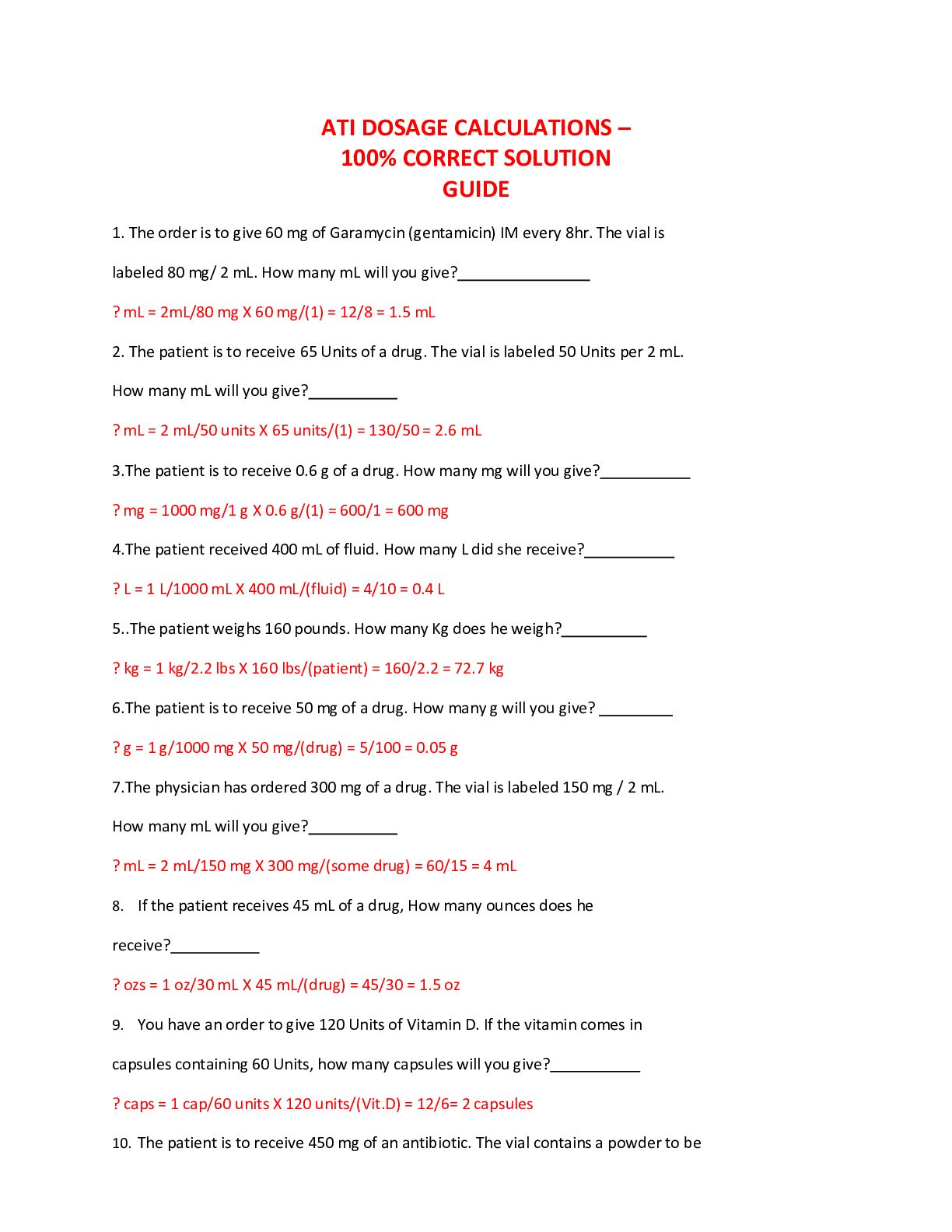
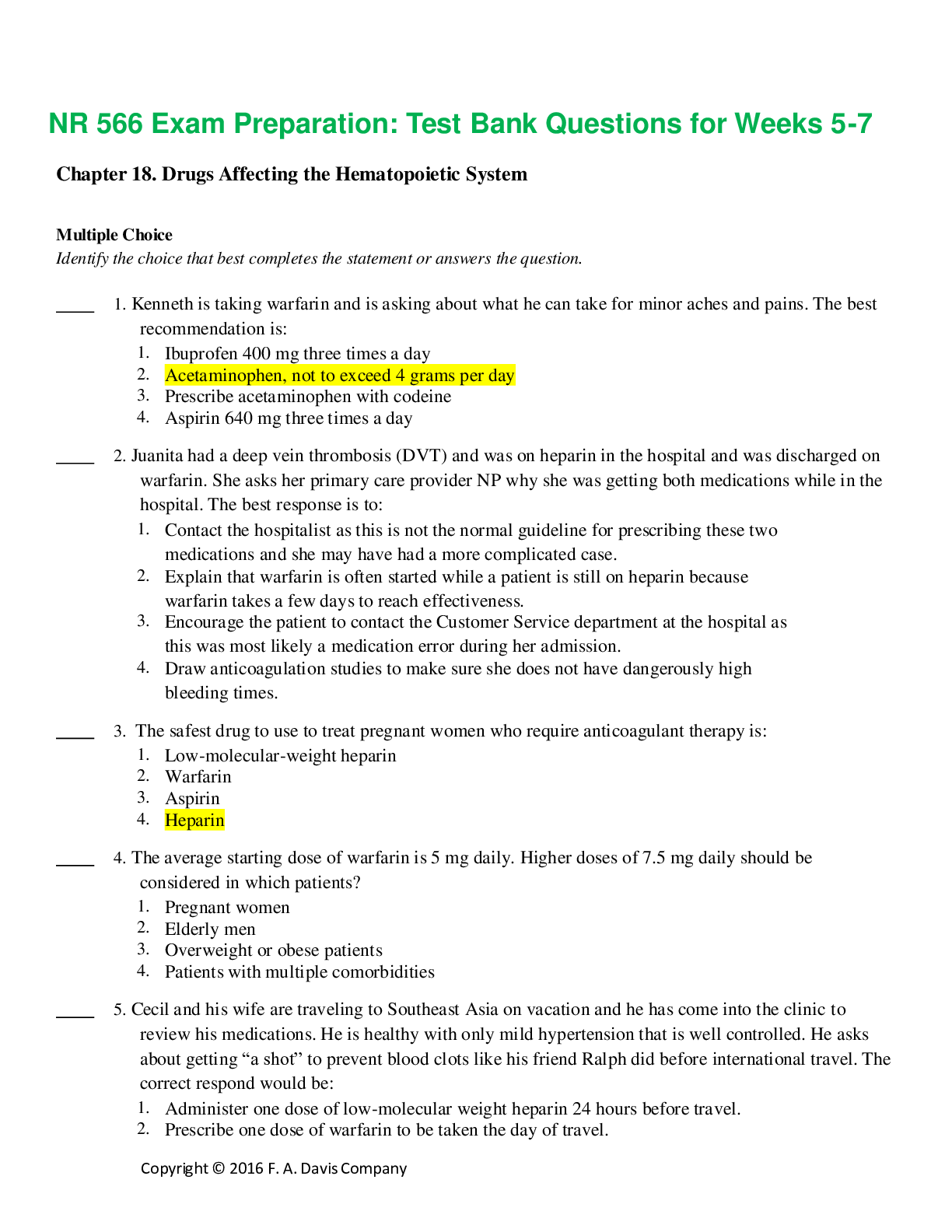
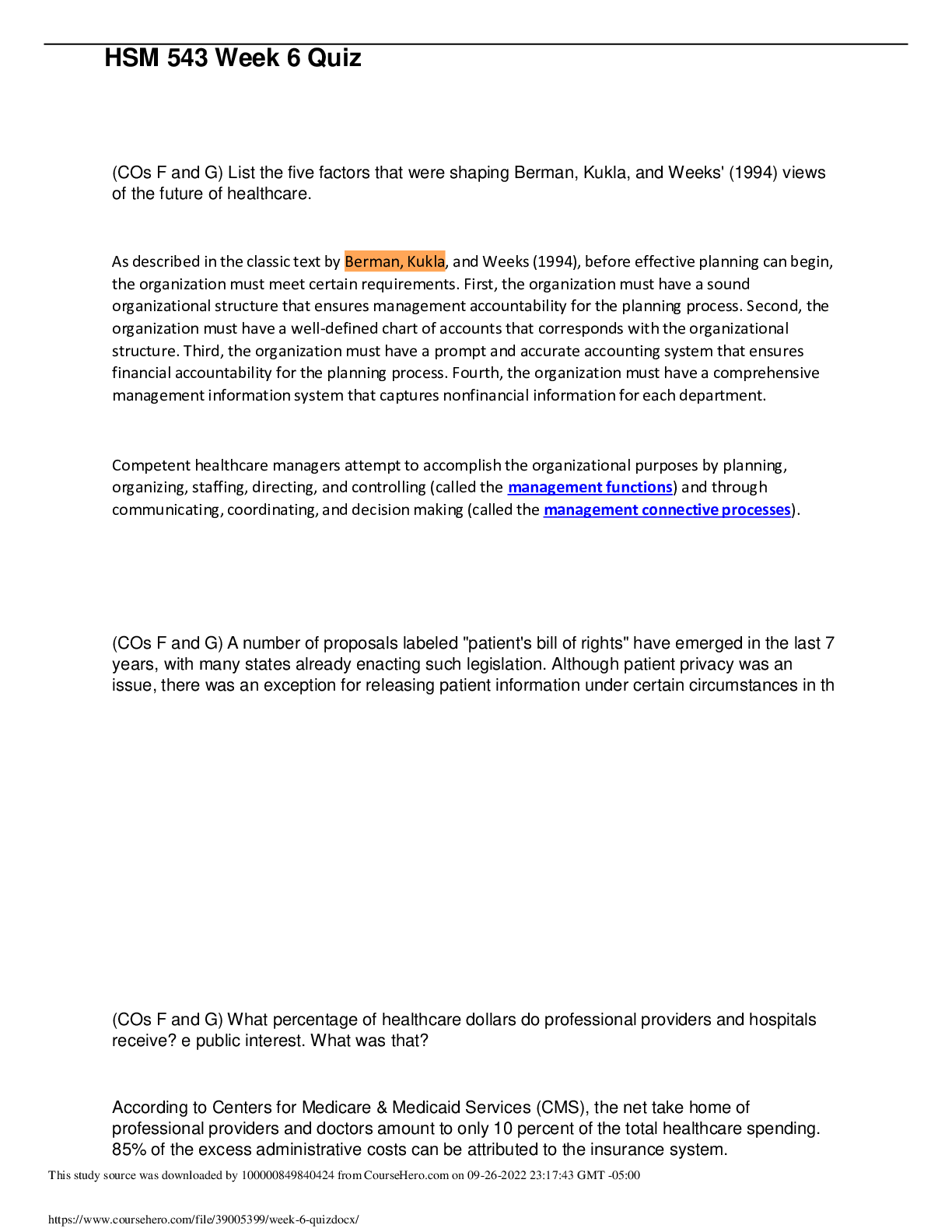

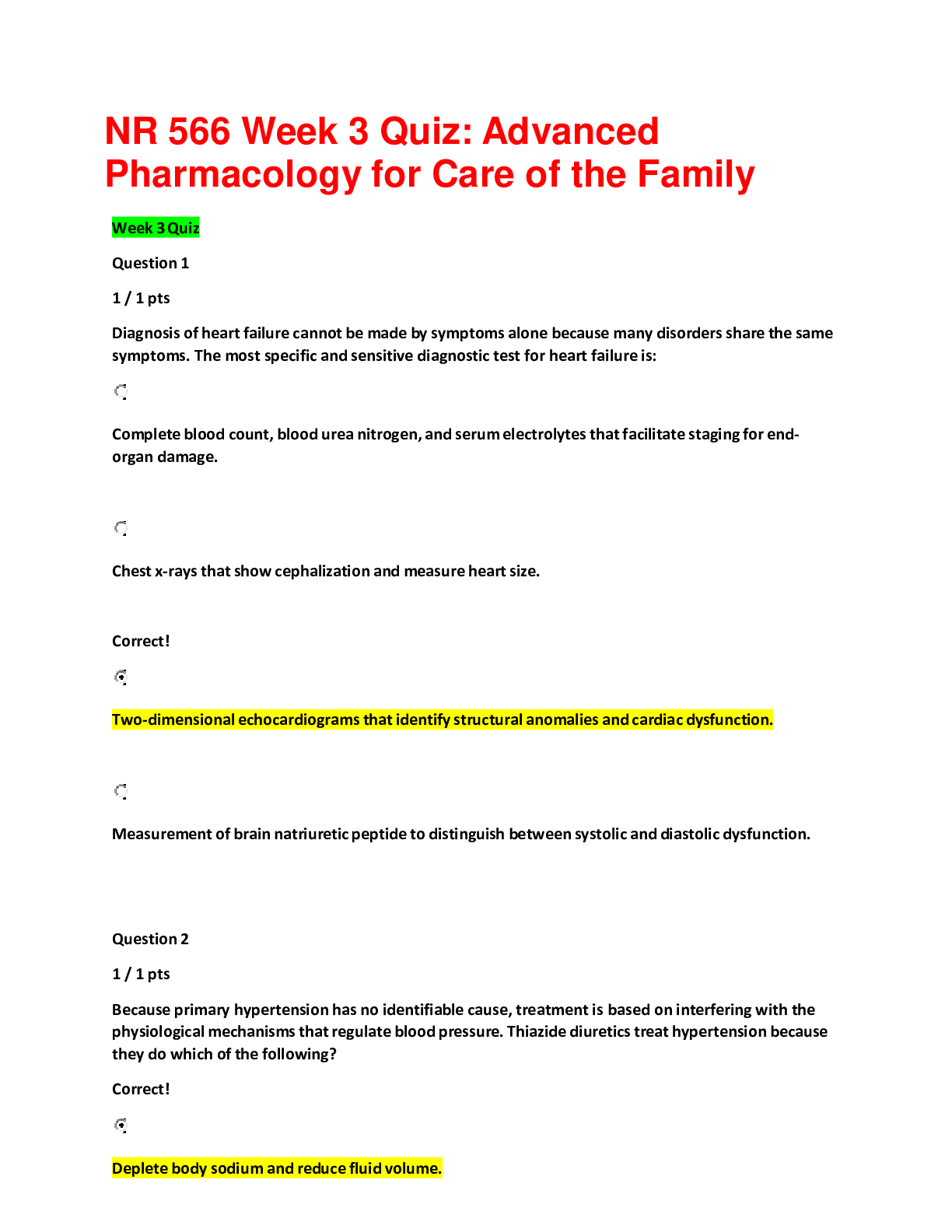
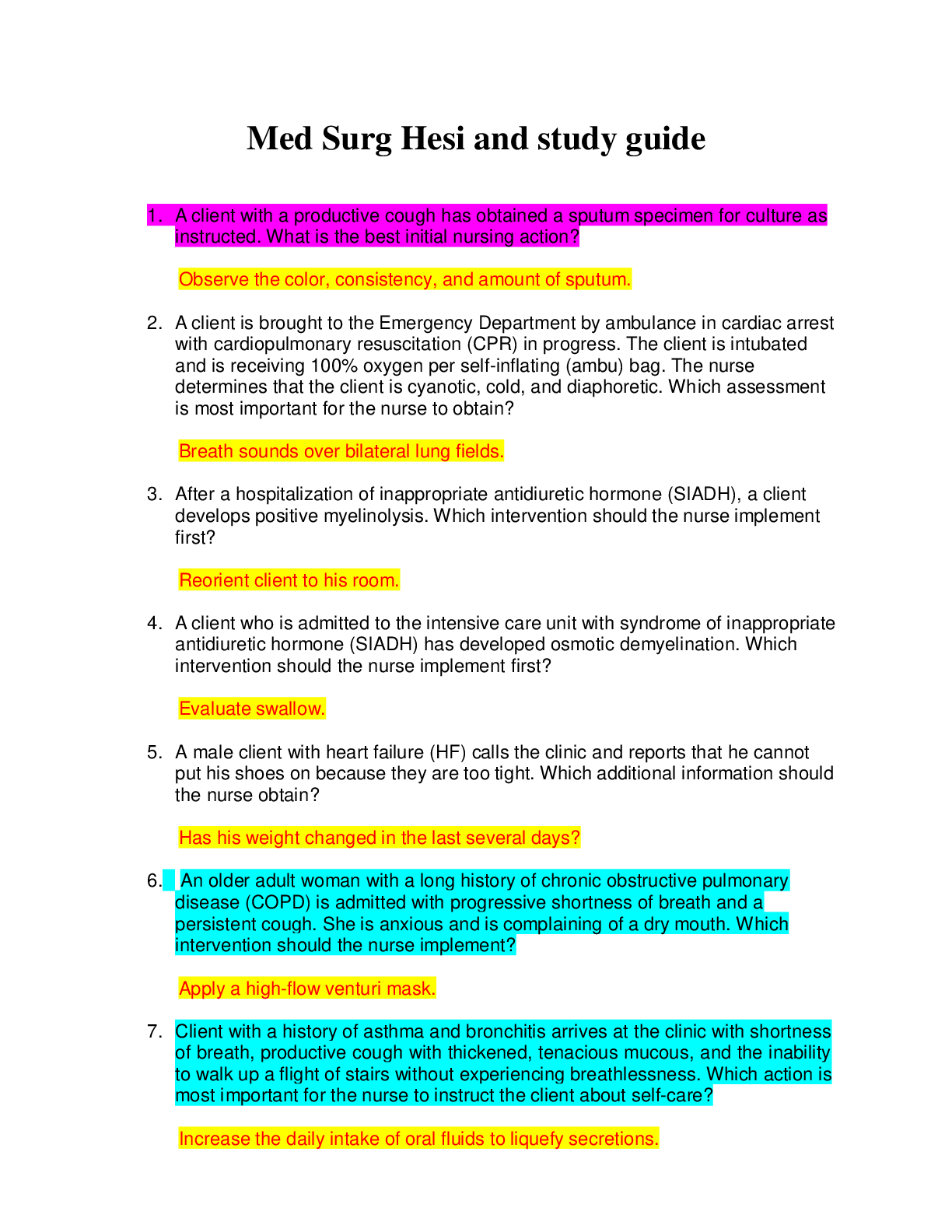

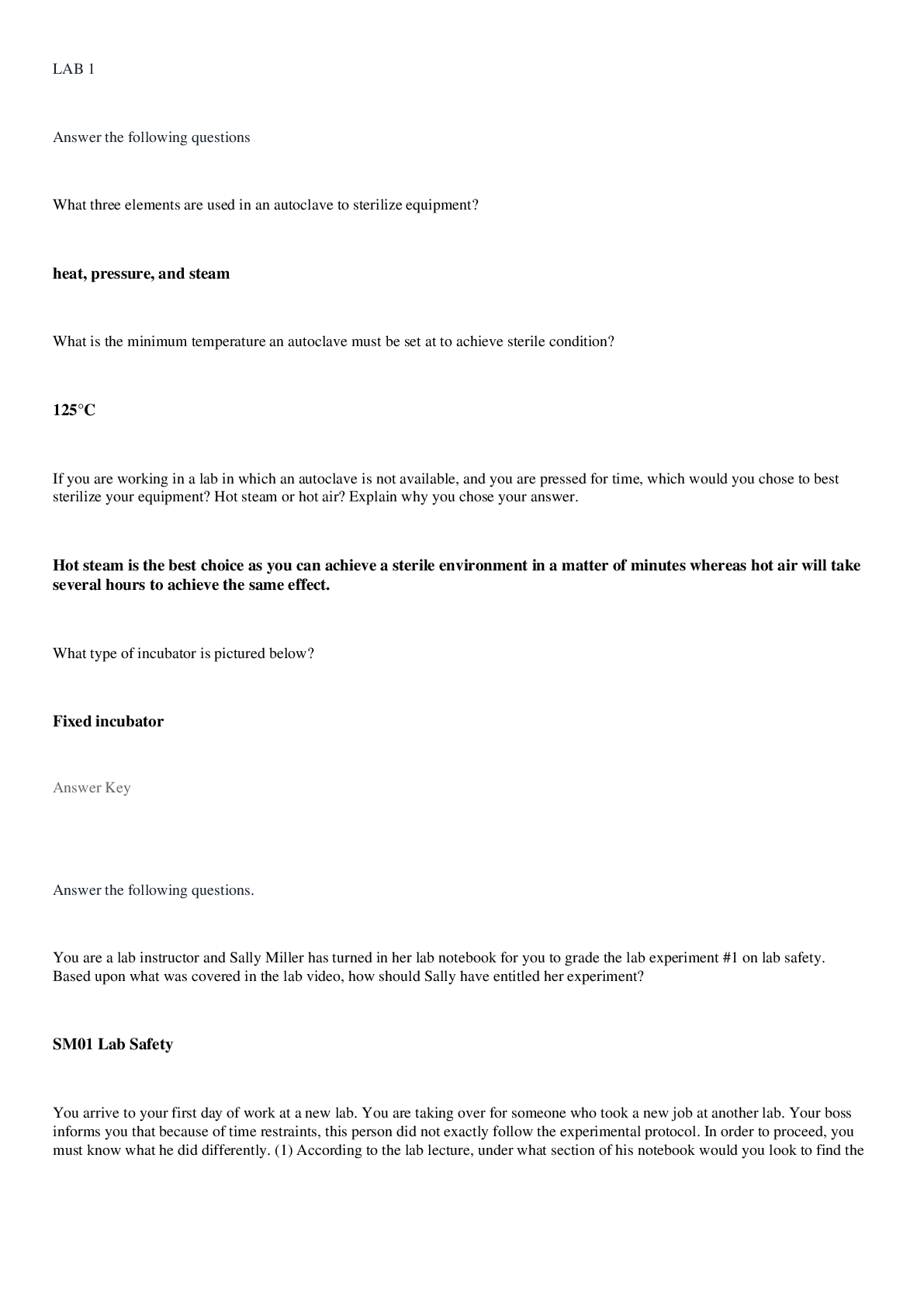
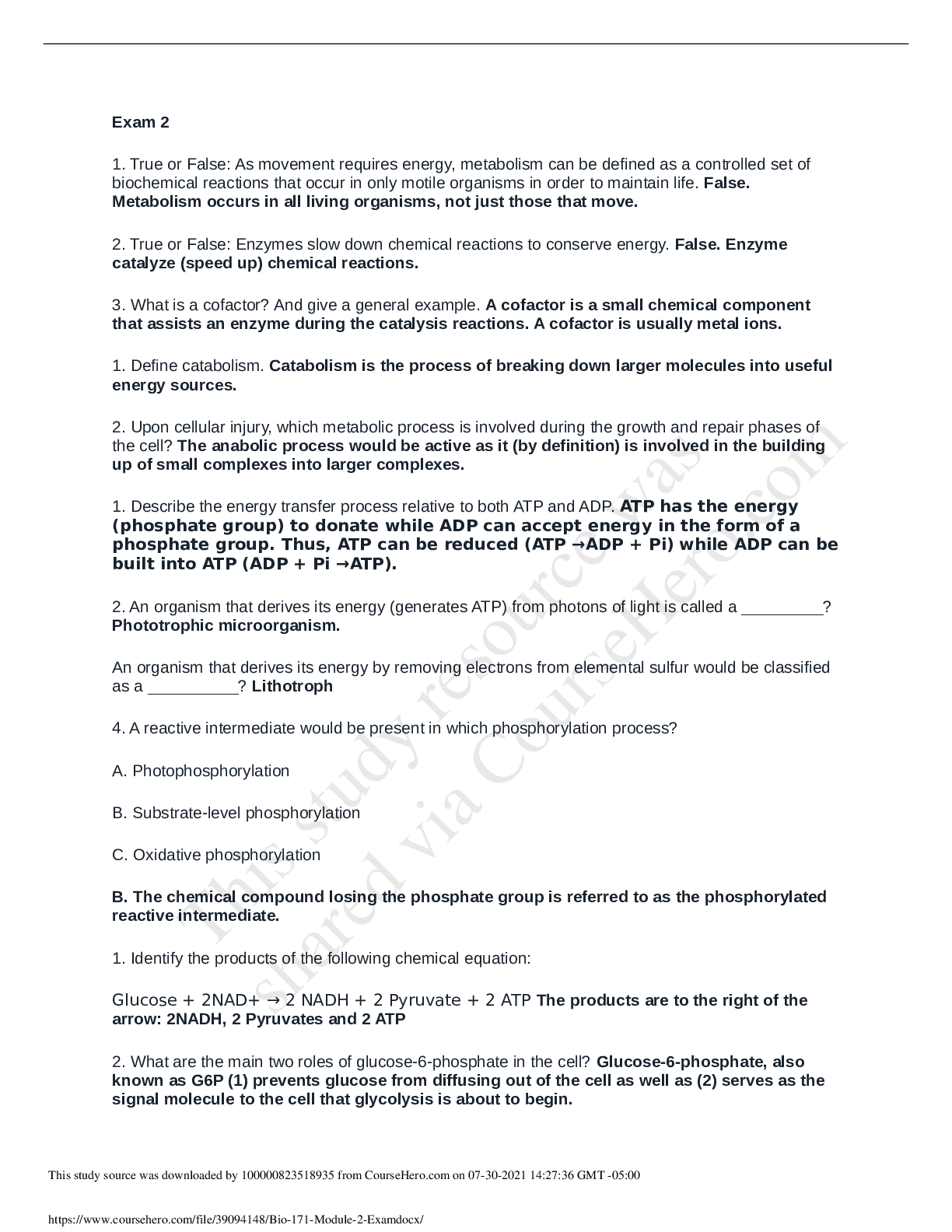
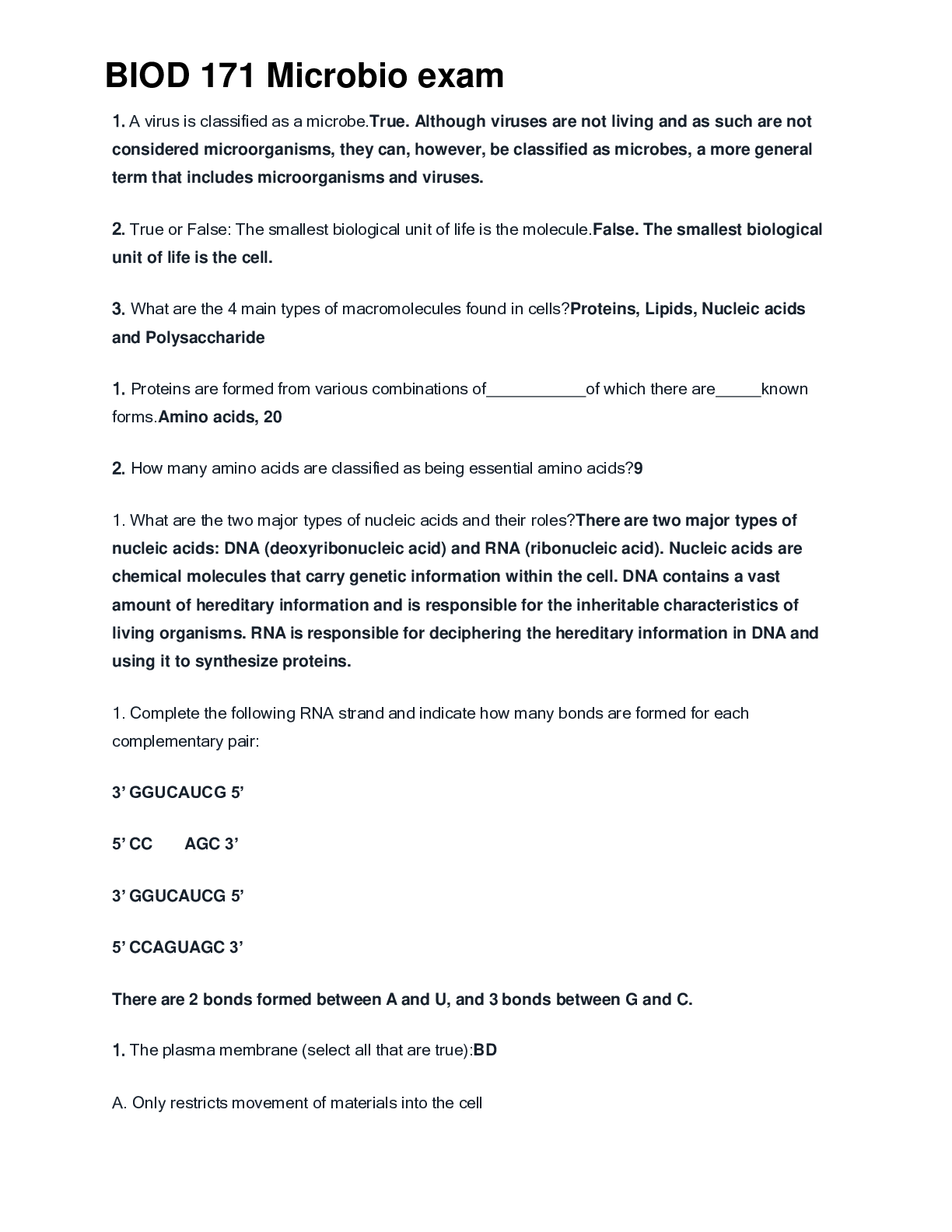

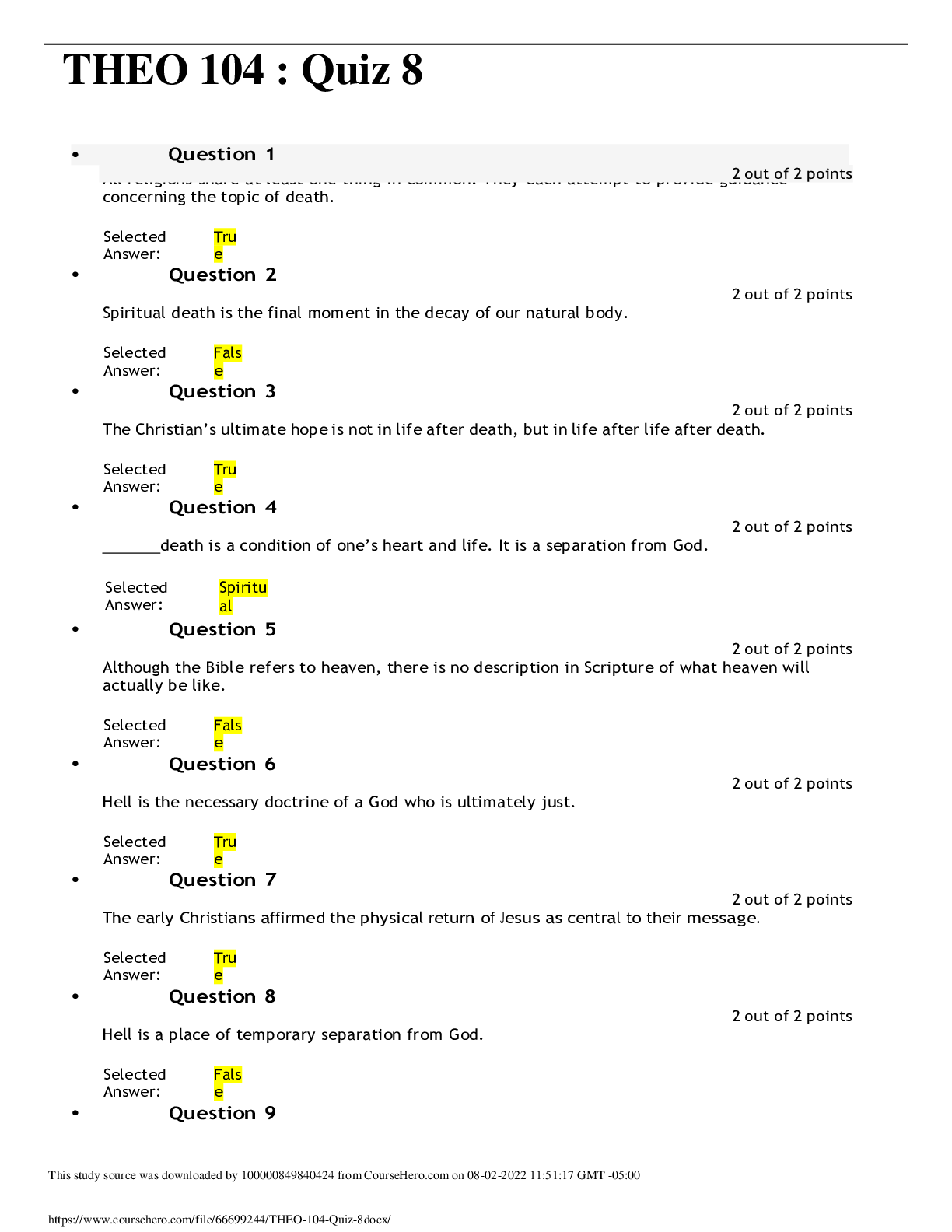
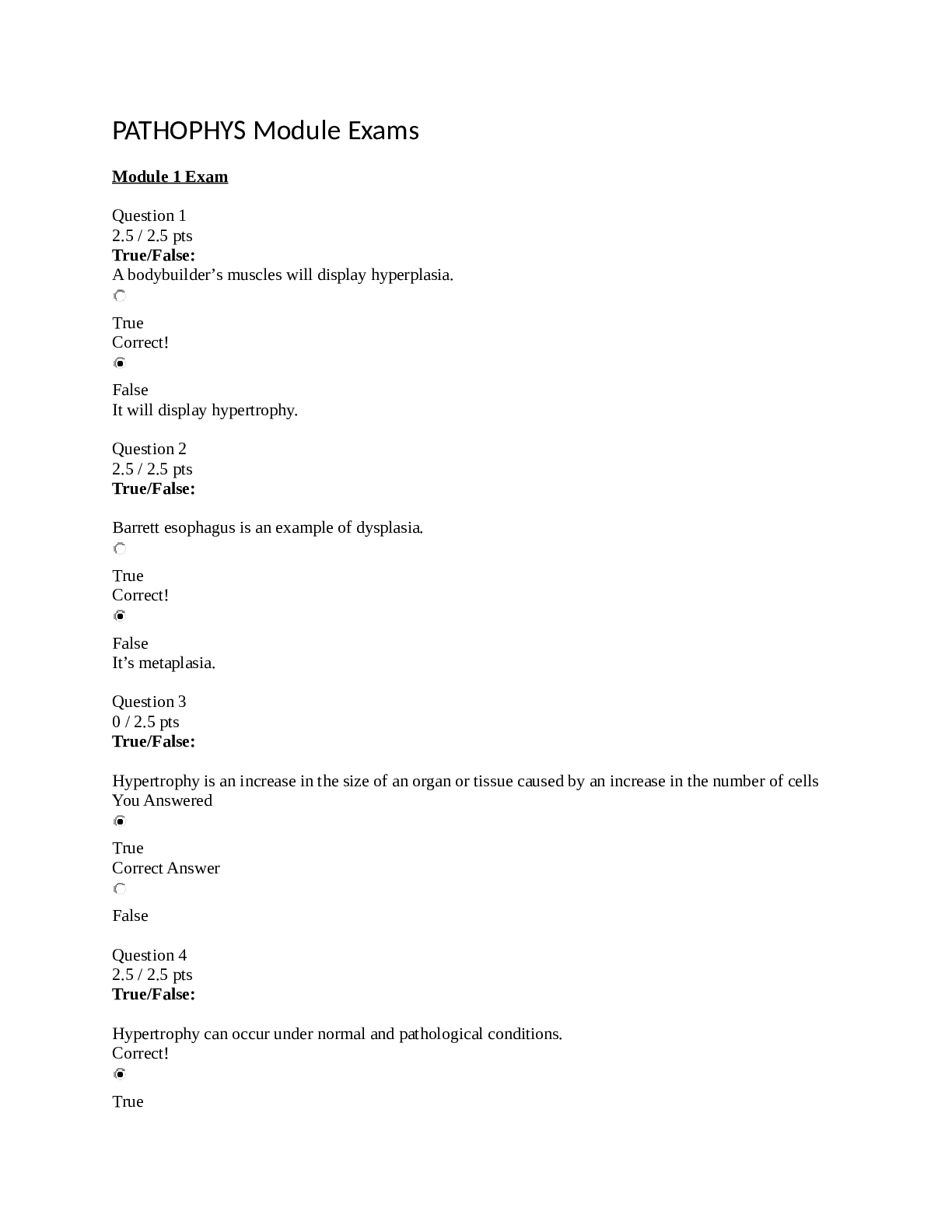
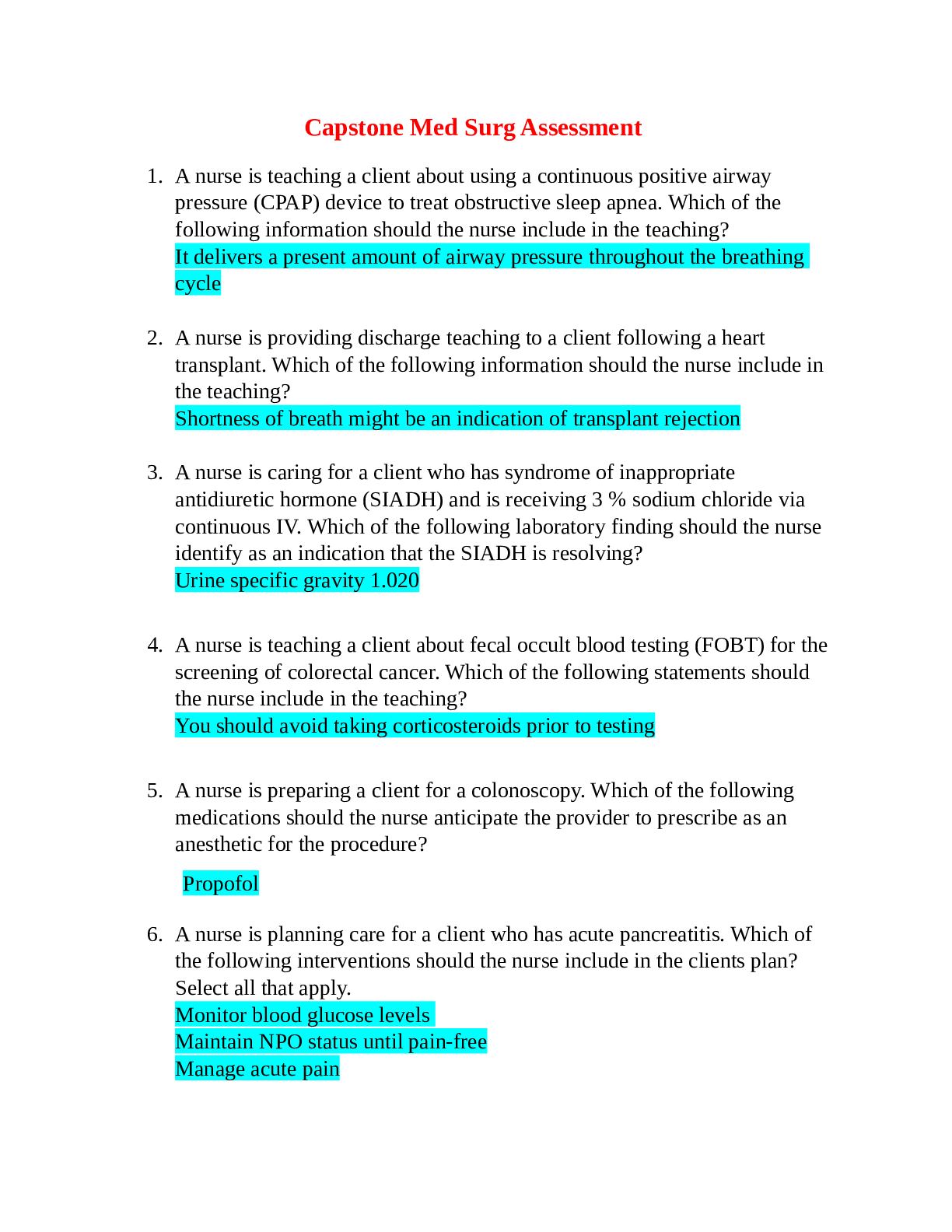
 (1).png)



